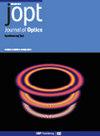Enhanced circular dichroism of an X-shaped nanostructure by asymmetric surface plasmon interference
IF 2.7
4区 物理与天体物理
Q3 OPTICS
引用次数: 0
Abstract
A plasmonic chiral structure, which is a nanostructure composed of noble metals that lacks planar symmetry, demonstrates significant potential for various applications in bio-sensing, optical forces, switching and controlling the photoluminescence, and detecting chiral light. Understanding its fundamental property of circular dichroism (CD) is critical for these applications. Although the surface plasmon resonance (SPR) mode at a specific moment can explain the CD properties of chiral structures, to gain a better understanding of chirality, the mode shape of the SPR on a nanostructure must be analyzed throughout an entire period. Our study proposes an X-shaped nanostructure to investigate the temporal evolution of plasmon resonance in chiral structures. The simulation results demonstrated that our structure exhibited a significant temporal evolution in plasmonic oscillations, providing new insights into the nature of chirality. In addition, we provided a comprehensive theoretical explanation of CD using the Born–Kuhn model. Furthermore, we discovered that the CD in the X-shaped structure was intensified by the asymmetric interference between the structure and underlying gold film substrate.通过非对称表面等离子体干涉增强 X 形纳米结构的圆二色性
质子手性结构是一种由贵金属组成的缺乏平面对称性的纳米结构,在生物传感、光学力、光致发光的开关和控制以及手性光探测等各种应用领域都具有巨大的潜力。了解其基本特性圆二色性(CD)对于这些应用至关重要。虽然特定时刻的表面等离子体共振(SPR)模式可以解释手性结构的 CD 特性,但要更好地理解手性,必须分析纳米结构上 SPR 在整个周期内的模式形状。我们的研究提出了一种 X 形纳米结构来研究手性结构中等离子体共振的时间演化。模拟结果表明,我们的结构在质子振荡中表现出显著的时间演化,为了解手性的本质提供了新的视角。此外,我们还利用 Born-Kuhn 模型对 CD 进行了全面的理论解释。此外,我们还发现 X 形结构中的 CD 因结构与底层金膜基底之间的不对称干涉而加剧。
本文章由计算机程序翻译,如有差异,请以英文原文为准。
求助全文
约1分钟内获得全文
求助全文
来源期刊

Journal of Optics
OPTICS-
CiteScore
4.50
自引率
4.80%
发文量
237
审稿时长
1.9 months
期刊介绍:
Journal of Optics publishes new experimental and theoretical research across all areas of pure and applied optics, both modern and classical. Research areas are categorised as:
Nanophotonics and plasmonics
Metamaterials and structured photonic materials
Quantum photonics
Biophotonics
Light-matter interactions
Nonlinear and ultrafast optics
Propagation, diffraction and scattering
Optical communication
Integrated optics
Photovoltaics and energy harvesting
We discourage incremental advances, purely numerical simulations without any validation, or research without a strong optics advance, e.g. computer algorithms applied to optical and imaging processes, equipment designs or material fabrication.
 求助内容:
求助内容: 应助结果提醒方式:
应助结果提醒方式:


